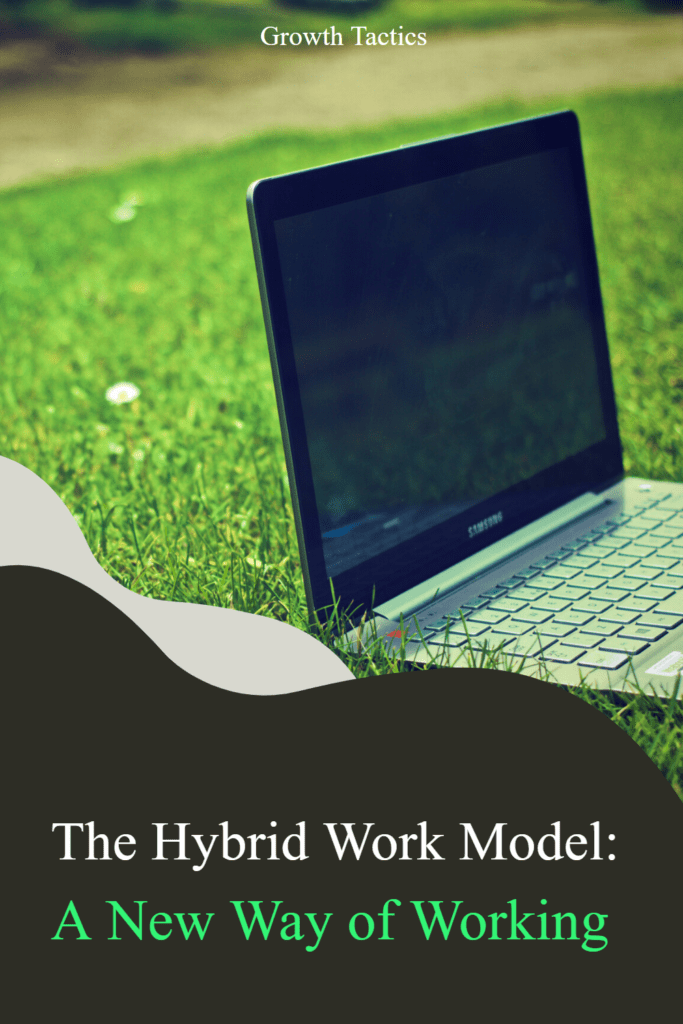The hybrid workplace model is a way of working that blends the flexibility of working from home with the benefits of having an office. The goal of this type of work environment is to encourage creativity and collaboration. By providing employees with the necessary tools to succeed. For your company’s hybrid workspace model to be successful, there are things you need to consider. In this article, we’ll discuss some hybrid work model best practices to promote work-life balance.
Jump To Section
What Is A Hybrid Workplace?
A hybrid workplace is a combination of traditional work environments and teleworking. For example, you may have an office space where all the employees get together But also have remote workers who can work from home or coworking spaces.
Hybrid work environments are becoming more common as businesses realize that they need to offer the best of both worlds. The flexibility and productivity benefits of working remotely combined with being able to collaborate with coworkers in person whenever necessary.

Cons Of A Hybrid Workplace
A hybrid workplace model is not the right choice for every company. But it can be a great fit for many teams.
One of the biggest cons of a hybrid workplace is that it can be difficult to establish clear boundaries between work and personal life. This can be particularly challenging when the workplace is located in your home. It can also be an issue if you work from home and have clients or customers who visit frequently. It’s important to make sure employees set aside time to take care of themselves. Even if it means turning off their phones or blocking off certain hours so that they can focus on their own needs.
Another con to hybrid workplaces is that they can be challenging for people who are used to working in traditional offices. For example, if you have a meeting with someone at 10 a.m. but they are late because they have trouble finding parking near your house. Then it may seem like there’s no point in starting on time or at all! You might end up spending more time waiting than actually working.
Hybrid workplaces also require communication skills from everyone involved. Both employees and employers need to know how to communicate effectively with one another without being too formal or too informal. This might mean setting up rules about when it’s appropriate for workers to contact managers. Whether it’s using text messages or email versus telephone calls (or even video chats).
The Benefits Of A Hybrid Workplace
Flexibility. One of the most popular benefits of a hybrid workplace is flexibility. Employees can choose where they want to work, whether it’s at an office or another location. It also gives them the option to work remotely if they prefer it that way. Or if other circumstances make it necessary (e.g., children to watch at home).
Improved productivity and performance. Several studies have shown that employees who work remotely are more productive than those who don’t. They’re not distracted by things like noise from coworkers or managers walking around in the office space looking for them. This can lead directly to improved company performance as well as employee engagement and retention rates!
Improved employee engagement/retention rates. The same reason why people are more productive when working remotely applies here too. Because fewer distractions mean a better focus on tasks at hand which equals results achieved faster with less effort.
The Hybrid Work Model Is Flexible
The hybrid workplace model is flexible. Flexible schedules, flexible locations, flexible work hours, flexible workspaces, and attire. The list goes on and on.
In a hybrid model workplace:
- Flexible schedules mean you could be working from home or the office. You can decide how much time you want to spend at your desk versus elsewhere in the office building or at another location altogether.
- Flexible location means employees are free to choose where they want to work each day (or week). If there are multiple branches nearby then this means fewer commutes for workers living farther away from headquarters which helps reduce stress levels caused by long commutes during rush hour traffic jams!
- Flexible work hours mean employees can set up their schedules. Depending on what works best for them personally. Instead of having someone else dictate when exactly those hours should be spent working each day/weekend etcetera). Some might prefer staying late one night per week. Others may opt out completely from working after hours because they have families waiting at home already. All options are available under this system!
Will Improve Your Company’s Culture
A hybrid workplace model is a good way to improve your company’s culture. This model allows employees to work in a variety of ways and enables them to work in a way that suits them best. It also encourages collaboration among workers, which can help build their skills and make them more valuable for the business.
Encourages New Hires To Join Your Team
A hybrid workplace model is an excellent way to attract and retain new hires. People are more likely to join a company that provides them with the opportunity to work in a space that’s both productive and comfortable. In fact, studies have shown that employees who feel comfortable at work are more productive than their less-comfortable counterparts. The idea of creating a hybrid workplace isn’t just about creating one physical office. Where people can meet each other face-to-face. It’s also about giving employees access to technology so they can stay connected with colleagues at all times.
The Hybrid Workplace Model Has A Positive Effect On Employee Retention
A flexible work environment is one of the most effective ways to keep employees happy and engaged. Happy employees are more likely to stay at your company and stay loyal to it. Which will lead them to recommend other potential candidates for the job. And this can be a very good thing for business: people who have been in an organization longer than 6 months are 2x as likely as those who have been there less than three months to recommend their employer’s brand or product.
The hybrid workplace model allows you not only to retain top performers but also to let them grow into new roles within your organization while maintaining continuity in leadership development and culture sharing. All while keeping costs down by reducing unnecessary real estate expenses.
Will Increase Productivity And Performance
In a hybrid workplace model, employees are able to work from home when needed and then come into the office for meetings that require face-to-face interaction. This gives them the opportunity to work remotely while also being able to collaborate with colleagues in person at times.
Employees have been shown to be more productive and satisfied when they are able to do their job wherever it makes sense for them. They can be more engaged with their work if they don’t have to commute every day. Or put up with an uncomfortable office space just because it’s necessary for their business.
See Related: 14 Easy Tips on How to Be More Productive
How To Get Started With The Hybrid Workplace Model
If you’re interested in creating a hybrid workplace model for your organization, it’s important to take the following steps:
Assessing Your Workplace Readiness
Before diving headfirst into the hybrid way of working, it’s crucial to assess your organization’s infrastructure, technology, and policies. Take a moment to evaluate if your current systems are capable of supporting this dynamic work model. Adequate internet connectivity, reliable software, and efficient collaboration tools should take center stage to ensure seamless remote collaboration. Additionally, identify potential challenges and areas for improvement, such as implementing new policies or upgrading your technology stack.
Defining Your Hybrid Work Policy
When it comes to implementing a hybrid workplace model, clarity is key. It’s crucial to establish a comprehensive policy that outlines expectations, guidelines, and procedures for both remote and in-office work. This policy should address crucial aspects, such as scheduling, communication, and performance evaluation. By creating a flexible and inclusive policy that caters to the needs of all employees, you can set the stage for a successful transition.
Engaging Employees
Transitioning to a hybrid workplace requires the active participation and support of your employees. Communication is vital during this process to ensure everyone is on board and understands the benefits of this new way of working. Regularly communicate updates, provide opportunities for feedback, and address any concerns that arise. By actively engaging and including all employees in the decision-making process, you can create a sense of teamwork and collaboration, regardless of their physical location.
Implementing Technological Solutions
Technology is the backbone of any hybrid workplace. Ensuring a reliable and secure technology infrastructure is essential for remote work success. Equip your employees with the necessary tools and equipment, such as laptops, VPN access, and collaboration software, to foster effective communication and collaboration. Moreover, provide comprehensive training on utilizing these technologies to maximize productivity and ensure a seamless remote work experience.
Balancing Workload and Scheduling
In a hybrid workplace, managing workload distribution and scheduling is crucial to avoid overwhelming certain individuals or teams. Develop a system that fairly allocates work among remote and in-office employees, taking into account their availability and preferences. By establishing guidelines for scheduling and encouraging open communication, you can ensure a balanced workload and maintain a harmonious work environment.
Creating a Collaborative Culture
Regardless of their physical location, it’s essential to foster a sense of connection and collaboration among your employees. Implement virtual meetings, team-building activities, and collaboration tools to promote effective communication and camaraderie. Encourage regular interaction and the exchange of ideas between remote and in-office employees to break down physical barriers and create a cohesive culture. Remember, a strong and inclusive company culture is the bedrock of any successful hybrid workplace.
Addressing Security and Privacy Concerns
In a world driven by technology, cybersecurity and privacy concerns are more critical than ever. Implement stringent cybersecurity measures to safeguard sensitive data in both remote and in-office settings. Educate your employees about best practices to prevent security breaches and adhere to privacy regulations and policies. By prioritizing data protection and privacy, you can empower your employees to work confidently and securely, regardless of their physical workspace.
Monitoring and Evaluating Performance
Measuring performance is vital to ensure that the hybrid workplace model is serving your organization effectively. Establish clear performance metrics and evaluation criteria for both remote and in-office employees. Leverage technology to track productivity and results, allowing for objective assessment and continuous improvement. Regularly review and adjust performance management strategies based on observed outcomes to keep your virtual teams motivated and ensure optimal productivity.

Hybrid Work Model Best Practices
- Focus On Communication
- Utilize Team Management Apps
- Set The Ground Rules Early
- Make Sure Everyone Knows The Goals
- Don’t Overlook Virtual Team Building Activities
- Ensure Employees Have The Necessary Resources
- Make Schedules Consistent and Transparent
Focus On Communication
Communication is the key to a successful hybrid workplace.
Team communication is essential to the success of your business. It’s also important for employees to feel included in company decisions. Good communication encourages employee engagement, which is good for business overall. According to a study by Stanford University’s Clayman Institute on Gender and Policy Studies. Companies with higher levels of employee engagement have better financial performance than those that don’t.
Additionally, good communication can help keep everyone on your team happy and motivated as they’re able to voice their concerns or share their ideas more easily with each other, and with you!
See Related: How To Foster Effective Team Communication in The Workplace
Utilize Team Management Apps
Team apps are a great way to communicate with your team and keep them on the same page. Here are some examples of team apps:
See Related: Team Management Apps List to Boost Your Teams Productivity and Effectivity
Set The Ground Rules Early
You should always set the ground rules clearly and early. This is vital because it helps to ensure that everyone involved in the project has a good idea of what is expected of them by the company, their manager, and each other.
The following section will give you a quick overview of some tips for communicating expectations with your employees to help make sure they’re clear on what’s expected of them:
- As an employer, it’s important to be clear about what you expect from your employees. You need to communicate how much time off they’ll be working and whether or not overtime will be required (and if so how much).
- It’s also important for managers and directors/managers above them (such as department heads) to communicate their expectations clearly so that there isn’t any confusion about what needs to be done in order for projects/tasks etc., to get completed successfully.
- As an employee, it’s important to let supervisors know what they expect as well. For instance, maybe they only want to take calls when they are on the clock or will answer messages while off duty but responses may be delayed.
Make Sure Everyone Knows The Goals
One of the most important parts of working in a hybrid workplace is defining goals for your team. You need to have a clear picture of what you want the team to achieve, and then make sure that everyone knows what those goals are.
When it comes to this step, it’s good practice to make sure that everyone understands how their goals align with the organization’s overall mission statement, as well as their manager’s personal objectives. It can also be helpful for employees to understand how their work fits into the larger-scale vision of their peers or colleagues on other teams.
Don’t Overlook Virtual Team Building
It is important to remember that virtual team building is not just about getting together as a group. It’s also about building relationships, trust, and morale within your teams across multiple locations.
Virtual team building helps you learn about what motivates your colleagues, what they’re passionate about, and how they think. You can also see how well they work together and how they react under pressure.
This kind of connection is essential because it gives you insight into each other’s personalities. This will help you create more effective teams that are able to work together better in the future.
See Related: 10 Fun Virtual Team Building Activities Your Employees Will Love
Ensure Employees Have The Necessary Resources
It is important that businesses ensure their employees have the necessary resources to do their jobs effectively. This is especially true when employees telework or work in a hybrid workplace.
In the world of business, it can often be difficult to make sure all employees have access to the right tools, training, and information they need in order to do their job well. If you want your company’s productivity and efficiency levels to increase then it is essential that you provide your staff with everything they need in order for them to achieve this goal.
The first step is ensuring that employees have access to quality equipment such as computers and printers and have a reliable electricity supply so that these machines can run properly without any interruptions or faults occurring during use time frames. Which could affect overall productivity levels if not dealt with quickly enough. Regular maintenance check-ups should take place every six months minimum to minimize something happening unexpectedly!
Make Schedules Consistent and Transparent
To keep your employees happy and productive, it’s important to make schedules as consistent and transparent as possible. Here are a few ways you can do this:
- Provide a clear process for scheduling. Make sure that employees know how to request time off in advance (a week or two in advance), so they can plan their personal lives accordingly. The same goes for special events if your company allows for paid time off for those situations, be sure that the rules are clearly communicated beforehand so there won’t be any confusion on either side later on.
- Ensure that schedules are as consistent as possible so other employees and clients know when people will be in the office and when they will be teleworking.
Conclusion
While the hybrid workplace model is still in its early stages of adoption, it has the potential to be a huge success. The benefits are clear: more productivity, better culture, less turnover, and higher performance. But there are also some challenges that need to be addressed before companies can fully embrace this new way of working.
One major challenge is finding a balance between remote workers and those sitting next to each other daily. Another is figuring out how much time should be spent on each task when no one is watching over shoulders anymore (although apps like Trello or Slack can help). The best thing about this new model though? It’s flexible enough so everyone can find something they’re comfortable with while still contributing towards common goals together!
Did you enjoy this article on the hybrid work model best practices? Please share below.


